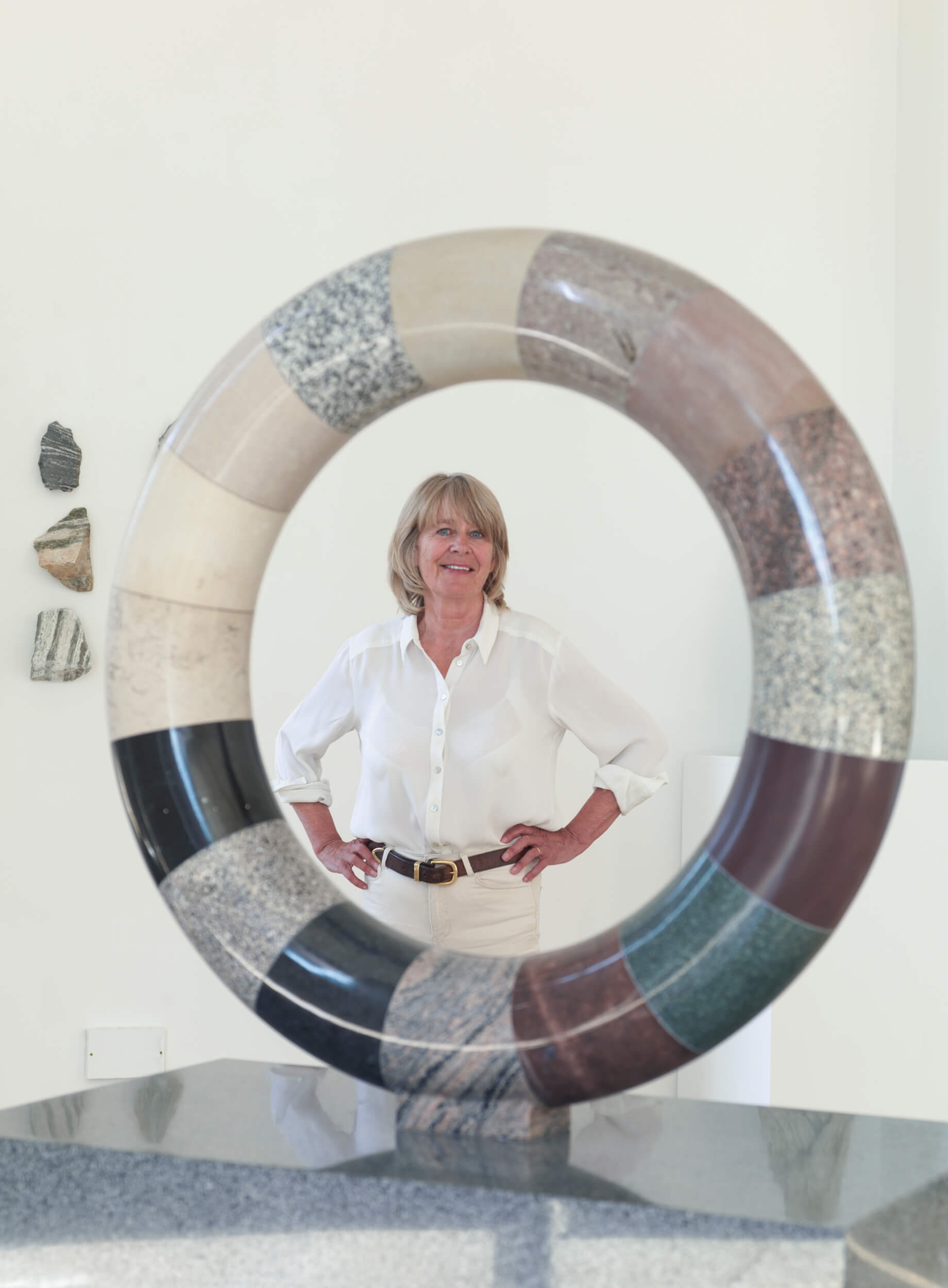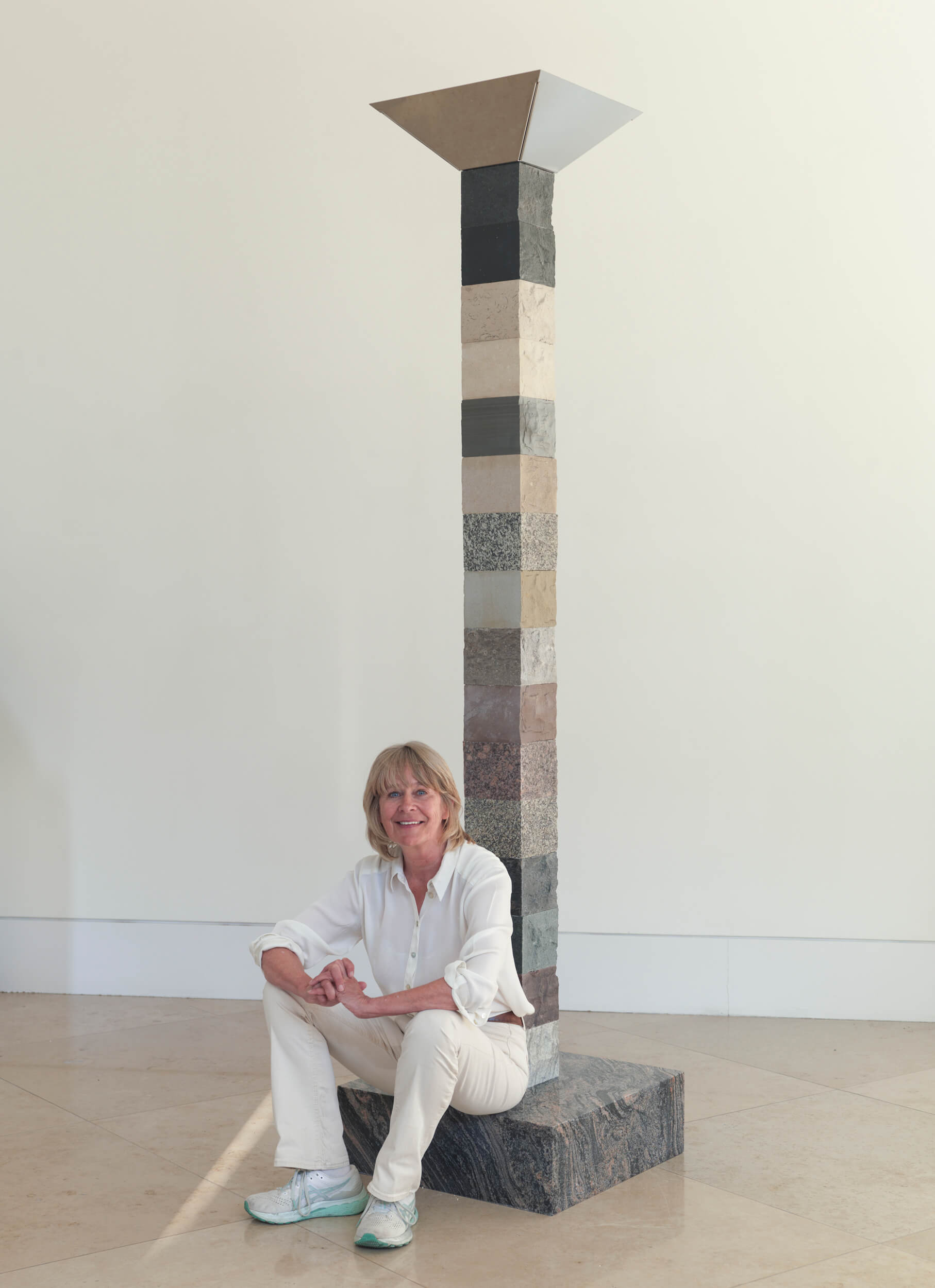As scientists today reveal the world’s ‘Golden Spike’ location to demonstrate how man has changed the planet, a new sculpture was unveiled in London to represent the Anthropocene.
Tower of Time is a 2.6m high column which charts our nation’s 3-billion-year timeline with 17 native rocks rising in sequence of age. From a base of 3-billion-year-old Lewisian Gneiss rock from the Outer Hebrides, the Tower culminates with an element representing the Anthropocene – the hand of man. Artist Angela Palmer has incorporated a highly polished stainless steel element atop the tower, reflecting the observer as they look up. Besides mirroring the onlooker, the steel symbolises the Industrial Revolution, which many believe is the starting point of the Anthropocene. In addition, steel is derived from iron, the component found within rocks. The artist points to a further connection, of iron existing both in rocks and within our bodies.

The Scottish artist, who previously transported enormous rainforest tree roots from Africa to Trafalgar Square for a landmark environmental installation, The Ghost Forest, said: “As modern humans, we have occupied less than 0.01% of the Earth’s existence. In that infinitesimally short period, we have done untold damage to the planet. Mother Nature is our benign landlady, whom we take for granted at our peril.”
Palmer added: “The rocks in this exhibition are the oldest material you are likely to ever hold in your hand. They were here billions of years before us, and will be part of the planet long after we have gone. They represent the eternal, in sharp contrast to the ephemeral existence of humanity.”
The Tower’s base of ancient Lewisian Gneiss – which is two-thirds the age of Earth – is followed by a 2.5-billion-year-old White Anorthosite rock from the Isle of Harris, the same type of rock found on the Moon, and brought back by the Apollo 15 mission in 1971.
Alongside the tower will be Torus of Time, a spectacular one-metre diameter ring presenting the country’s 3-billion-year history as a ‘circle of time’, a homage to the ‘Father of Modern Geology’, James Hutton who made the revolutionary declaration in 1788 that the Earth showed ‘no vestige of a beginning, no prospect of an end.’
The exhibition also illuminates us to the genesis of our nation, of which few of us are aware: that the land on which we stand, and which Britons know as home, was originally located in the Southern Hemisphere, close to the South Pole.
Angela Palmer comments: “When I began this project I had no idea that our country originated near the South Pole, and that for billions of years Scotland and Northern Ireland enjoyed an entirely separate existence on a different continent to England and Wales. It was only when the tectonic plates shifted that they collided and were physically united, just south of the Equator, 400m to 425m years ago.”
The artist continues, “England and Scotland were ‘stitched’ together as a united country at roughly the same location as today’s Anglo-Scottish border. I hope observers will unlock their imaginations and allow themselves to be propelled to the South Pole where the most ancient of these rocks in this exhibition began their journey – a silent world with little oxygen, with no trees nor fish nor birds nor beasts.”

The exhibition will also feature a sculpture entitled The Four Nations, a complex interlocking block of four separate rocks, which can be assembled and disassembled, consisting of black basalt for Northern Ireland; Portland stone for England; pink Morayshire granite for Scotland; and Anglesey limestone for Wales. “It is not about what divides us but what makes each nation different, what gives it its own identity and character” adds Palmer.
Deep Time offers a unique portrait of our nation, capturing the materials, colours and textures imprinted on our land from the rocks below, which were used to build our homes, from the most modest to the grandest, our institutions, our country’s landmark buildings, and our bridges.
In addition to the stone sculptures, several works made of teak will tell a different story of time and the relationship between humankind and nature. The wood in Palmer’s exhibits originated in Burmese tropical forests and had been purchased by the British Crown during the First World War for warship construction.
The teak was en route from Yangon (then Rangoon) in July, 1917 to Liverpool dockyards when its cargo ship, Pegu, was torpedoed by a German U-boat just off Galley Head in the Irish Sea. Today, the shipwrecked Pegu lies close to RMS Lusitania which had been sunk in 1915, leading to the eventual United States’ declaration of war on Germany in December 1917. The teak on board Pegu lay undisturbed on the seabed for a century before it was raised and brought to Palmer’s attention. She was immediately drawn to the natural beauty of the underwater ‘carvings’ of the wood’s soft core by marine boring insects over the past century. The incredible density of teak meant that the outer layer has scarcely been penetrated, and to demonstrate its astonishing condition, Palmer has polished the preserved wood to highlight its richly varied red hue. She has however left untouched ‘nature’s carvings’, along with the historic seals of the British Crown and the stamps of Bombay Burmah Trading Company Limited.
In Deep Time, Palmer continues her exploration at the frontier of art and science, prompting us all to reflect and appreciate the sheer scale and power of the natural world around us, so essential to our very existence.
About Angela Palmer
Angela Palmer (b. 1957) is a Scottish artist who began life as a journalist, working as News Editor at The Observer (1986-1988) and Magazine Editor for The Observer (1988-1992) before moving to Elle Magazine as Editor-in-Chief (1992-1993). In 2002, Palmer changed careers and studied Fine Art at the Ruskin School of Drawing and Fine Art, University of Oxford where she received the Fitzgerald Prize for her work, before continuing her studies with a master’s degree at the Royal College of Art.
Palmer’s work is in the permanent collections of museums worldwide, including The Science Museum in London; The National Galleries of Scotland; the Smithsonian Air and Space in Washington, US; and The Ashmolean Museum in Oxford. Palmer’s sculptures were exhibited at the Guggenheim’s 25th anniversary exhibition in Bilbao last year. Her environmental installation, The Ghost Forest, which was exhibited in Trafalgar Square, Copenhagen and Oxford, is now in the National Botanic Garden of Wales. Her sculpture of the Coronavirus particle, 2020: The Sphere that Changed the World, was acquired by the Science Museum in London and is currently in its major exhibition, Injecting Hope.
About Pangolin London Gallery
Pangolin London are sculpture specialists and are one of London’s few galleries dedicated to exhibiting sculpture. Representing a solid stable of both established and emerging artists and artist estates, Pangolin London curates a dynamic exhibition programme that focuses on the historic developments of British Sculpture as well as the cutting-edge contemporary.
Pangolin London’s affiliation with Europe’s leading sculpture foundry, Pangolin Editions, enables the gallery to offer a unique service to both collector and artist alike with expertise in all areas of the making, commissioning and installation of sculpture. To support sculpture from grass roots, the gallery also organises a bi-annual sculpture residency in collaboration with the PJLF Arts Fund. Based in Kings Cross, Pangolin London not only exhibits sculpture in its sleek and specially designed gallery but also throughout the public spaces of the culture hub Kings Place and along the canal-side.
Exhibition Details
Dates Until Saturday 16th September 2023
Times Monday-Saturday 10am-6pm
Location Pangolin London Gallery, Kings Pace, 90 Kings Way
Social Media Twitter: @PangolinLondon, Instagram: Pangolin.London
Website www.pangolinlondon.com






















